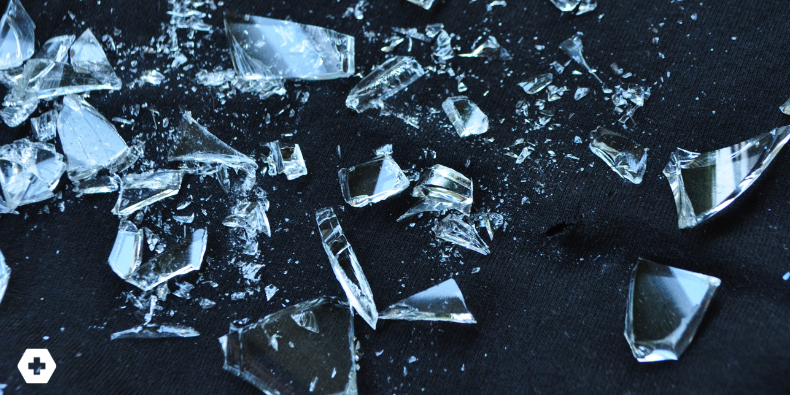
Legal Lessons: It’s Just a Flesh Wound… or Is It?

In the fast pace of urgent care, laceration!
s are our bread and butter. A few sutures, a tetanus shot, and a cheerful “all set!” send many patients back out the door feeling stitched-up and satisfied. But some of those patients come back—with more than meets the eye. One of the biggest (and most litigious) culprits? Missed glass foreign bodies in lacerations.
When a Cut Isn’t Just a Cut
Let’s start with two real cases featured on Dr. Eric Funk’s website, Med Mal Reviewer.
Case 1: A 35-year-old man comes in after falling while carrying a glass. He had a 4 cm open laceration on his forearm, and his neurovascular exam was normal. It was irrigated, sutured, and he was sent home. A few months later, he’s back—with numbness, weakness, and pain in his hand. Turns out, there was a shard of glass left behind. A hand surgeon finds it and removes it, but the patient now has permanent dysfunction from an ulnar nerve injury. He sues.
Case 2: A 45-year-old man sustained a laceration to the webspace between his index and middle fingers after dropping a glass at work. At initial presentation, he had full flexion and extension and was discharged after the wound was sutured. Over the following months, he continued to experience persistent pain and noticed a palpable bump in the area. A hand surgeon eventually removed a thin sliver of glass measuring 1.5 cm by 2 mm. The patient pursued legal action.
Glass Happens. Here’s What to Do About It.
We don’t share this to stoke fear, but to emphasize the high stakes of missed glass in hand lacerations and the value of a few simple practices that can help protect both our patients and ourselves.
1. Know When to Image
We’re not suggesting an X-ray for every paper cut. But for any lacerations involving glass—or anything likely to splinter—imaging can be crucial. Why should we not just trust our gut?
-
▪️Glass shows up well on X-ray: Studies show that 2mm glass fragments have a 99% detection rate on plain films, and even 1mm pieces are detected 83% of the time.
-
▪️Patient complaints are unreliable: The positive predictive value of a patient feeling like something’s in there? Just 31%.
-
▪️Ultrasound has a role too: If you’ve got it, it can be helpful for detecting foreign bodies, especially if the X-ray is negative and suspicion remains high.
Bottom line: If there’s a reasonable chance glass got into the wound, get the X-ray. Especially in the hand, where the consequences of a missed shard can be severe: just think of all those little nerves in your hand that control precise, fine movements!
2. Document Like a Pro
As always, a good and well-documented neurovascular exam can be your best defense. Include the usual suspects: flexion, extension, two-point discrimination, capillary refill, radial pulse, etc.. Some clinicians even re-check and document neurovascular status after wound closure or reduction.
Here’s my dot phrase that I use as a mental checklist of all the things you should check for on exam:
“Able to flex/extend all DIP, PIP, MCP, IP joints; sensation intact to radial, median, and ulnar nerve distributions; capillary refill <2 seconds; no scissoring or angulation. Digits neurovascularly intact.”
This will help you remember to be thorough and to catch any deficits that might exist on Day 0.
3. Don’t Forget the Follow-Up Plan
Another missed opportunity in both cases? Patient education. Even if a wound seems clean and neurovascularly intact, set the stage for what to watch for and when to return.
Say something like:
“There’s a small chance that a tiny piece of glass could still be inside. Even though we don’t see anything now. If you notice new pain, numbness, or a bump, come back and see us or follow up with this hand specialist.” … and then give them the name of your go-to neighborhood hand surgeon.
Then document the conversation. It’s not about covering yourself—it’s about preparing the patient and giving them a plan. Patients will likely be less surprised about a complication if you had warned them that it was a possibility, and also provided them with an avenue to address it.
4. Remember: Hands Are High Risk
Both of these legal cases involved hand lacerations. Hands are intricate, functional, and unforgiving of missed injuries.
Final Takeaways
Glass in lacerations is more common than you think—foreign bodies are found in up to 15% of hand wounds that get imaged, and in 7–9% of all wounds caused by glass.
Don’t rely on patient perception–or your own perception–alone to guide imaging decisions.
Radiographs have excellent sensitivity for most glass—use them when there’s even a sliver of doubt.
Document your exam, your thought process, and your patient instructions with clarity.
And remember: giving patients a heads-up about what could go wrong might be the most important suture you place.
Practice-Changing Education
Experience education that goes beyond theory. Explore Hippo Education’s offerings below.

